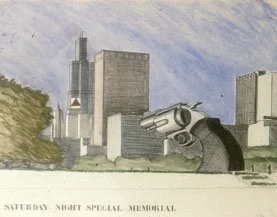Concepts
All American Walking Stick Company
2016-2022
I have a patent on the design of a baseball walking stick. Architect Howard McAlpine and I set up a company to make this product. We could not make the economics work because of licensing difficulties with major league teams.
MOULA
(Museum of Urban Los Angeles)
The Herald Examiner Building designed by Julia Morgan for William Randolph Hearst lay vacant for many years after the newspaper closed. I proposed that this beautiful building which has an apartment on its top floor from which Hearst could watch his employees compose the daily tabloid from his balcony through the skylights above the newsroom. The building is perfect to tell the story of Los Angeles. There could be exhibitions any of them interactive: on the Indigenous People, who camped along the meandering stream, to the Corps of Engineers, who tamed the river in a concrete channel, on the rapid growth of the city from a pueblo in Spanish colonial days to the current megalopolis fueled by the land speculation at the turn of the 20th Century, on The Treaty of Cahuenga, when the Californios ceded California, presently the sixth largest economy in the world, to General John C. Fremont and the United States in 1847, on the riots in Watts and after the acquittal of the police who beat Rodney King, on the beginning of the movie industry and impact of celebrity scandals like the murder of Nicole Simpson and on LA in novels, especially the noir works of Raymond Chandler and the detective fiction of Michael Connelly numerous. Today MOULA is but a dream. The Herald Examiner building is now occupied by an architecture school, but that could change. Los Angeles is a city always changing.
Gun Attractions for The United States
I conceived of two gun monuments that people could interact with and relieve their aggressions.
The “Saturday Night Special” monument was designed in 1973 for Grant Park in Chicago. I designed a 45-caliber handgun pointing down one of the streets that ended at the park. This enormous gun would allow visitors to climb up its handle to a platform. A guest would be inside the gun with a huge firing pin above, a rotating cylinder before them and the barrel beyond to see the street in the distance. A visitor could cock the firing pin, hear the cylinder rotate, then squeeze the trigger, while a puff of air and a wisp of smoke emerged from the barrel. They could listen to the pop of the gun firing. The sound would not go beyond the visitor’s platform.
I designed the “National Rifle Monument” for the plains outside Laramie, 1977. A long-barreled rifle with a scope on top was set level into the ground. A visitor could ascend to the inside of the telescope and see the mountains several miles away, where rustler roasts were said to be hidden in the pine forest. The scope could be adjusted to focus on a limited area in the trees. Like the Saturday Night Special monument, the rifle could be cocked and fired, but no puff of air, no wisp of smoke. A narrow beam of laser light would cross the plains and strike the mountains. No one appreciated my idea of how to celabrate American gun culture.
1972, Colored Pencil drawing 12” x 18” (30.48 x 45.72 cm)
In collection of Roberta Kent
National Rifle Monument, Wyoming, 1976, Colored Pencil, Watercolor and Collage, 18” x 24” (45.72 x 60.96 cm)
GIPS
Giant Illuminated Pylon Signs
Giant Illuminated Pylon Signs are the most powerful visual icons on the American landscape. At night and in daylight they populate the horizon. Like gigantic other-world mechanical spears and forks, GIPS dominate the freeways, interstate highways and smaller roadways, commercial strips of small and big cities, which could announce their cultural institutions. I thought art signs would be a worthy testament to and marker of an American aesthetic. They were conceived of as a bright companion to Claes Oldenburg’s pop sculptures.
Eat, Art, Gas signs for Laramie, Wyoming. 1976. Colored Pencil and Ink on Paper, 12” x 18” (30.48 x 45.72 cm), collection of Walter Impert
Art sign for the Contemporary Museum of Art, Chicago 1974. Colored Pencil and Ink on Paper, 12” x 18” (30.48 x 45.72 cm)









